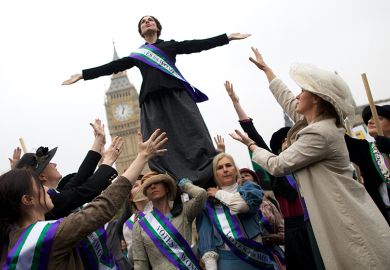Writing in 1991, the influential film theorist, Teresa de Lauretis, observed that queer theory marks "a certain critical distance" from some of the "ideological liabilities" attached to the labels "lesbian", "gay", and "homosexual". For academics developing work on same-sex desire in the past decade, these latter terms have at times created obstacles to critical understandings of gender and sexuality. It is not just that "homosexual" has been gradually rejected because of the traditional pathologising stigma attached to it. The word, after all, was often used in conjunction with "sexual inversion," a wholly discredited model for comprehending same-sex desire. Rather, both "lesbian" and "gay", while politically empowering, rested on what we might call "identitarian" assumptions. They tended to assume that specific identities were fixed by sexual object-choice. And their "identity politics" has increasingly been viewed as restrictive, falsely suggesting that such categories have an inner coherence.
Not only that, significant distinctions between lesbian studies and gay studies have revealed how inappropriate it now is to speak too inclusively of lesbian and gay studies. For where gay male scholars have often followed Michel Foucault in stressing the significance of sexual transgression, lesbian studies has paid much more attention to the social construction of gender. "Queer theory", writes De Lauretis, "was arrived at in the effort to avoid all these fine distinctions in our discursive protocols, not to adhere to any one of the given terms I but instead to both transgress and transcend them - or at the very least problematise them." Focusing on popular culture, both collections undertake this task by providing innovative ways of articulating complex structures of desire and identification.
As Paul Burston and Colin Richardson remark in their introduction to A Queer Romance, "part of the project of queer is to attack I the very 'naturalness' of gender and, by extension, the fictions supporting compulsory heterosexuality". They draw attention to a large body of work deriving from Freudian and Lacanian paradigms, not least the essay that has probably been cited more often in feminist film theory than any other: Laura Mulvey's "Visual Pleasure and Narrative Cinema." Mulvey's inquiry into the male gaze has prompted many subsequent explorations of how gender-specificity and sexual preference inform a broad repertoire of spectatorial looks.
Giving priority to visual pleasure, A Queer Romance opens with three essays that explore whether one can or should designate as an identifiable lesbian or gay gaze. Caroline Evans and Lorraine Gamman analyse some of the main areas of contestation within "gaze theory", from the ways in which an emphasis on the "male objectification of women can foreclose attention to issues of female spectatorship to the enduring repression of ethnic differences in much film criticism, which still frequently assumes that the viewer is white. Having identified these limitations, Evans and Gamman consider a number of distinctive visual texts - including the "gender****" photography of Della Grace - that mobilise "polymorphous identifications", ones where neat oppositions between masculine and feminine, heterosexual and homosexual, are radically destabilised. Such moments, they argue, are "queer."
But "queer" for whom? The problem with Evans and Gamman's important essay, as they admit, is that it embarks on a large project that necessarily prompts more questions than it can answer about who is looking, how that spectator is looking, and the context in which such looking occurs. Two other essays seek to specify spectatorial pleasure more precisely. Z. Isiling Nataf's essay on black lesbian viewing accentuates those moments in feature films, such as Mona Lisa (1986), that make themselves available to "queer" appropriation. By comparison, Steve Drukman attempts to identify how "MTV's beat keeps the gay gaze alert." But the more "polymorphous" these "queer" moments appear, the more it seems that they have as much a constitutive role as a destabilising one in the production of popular culture. Maybe the "norm" is queerer than we had previously imagined.
In a similar vein, Out in Culture is largely focused on film and its pleasurable potentialities. Bringing together some of the best-known essays that have shaped lesbian, gay, not to say queer theory in the past 15 years, editors Corey Creekmur and Alexander Doty insist that even though "gays and lesbians can experience and make meaning of mass culture in the ways the culture industries encourage," it remains the case that they "have also related to mass culture differently, through an alternative or negotiated, if not always fully subversive, reception" of the popular. Originally planned as an anthology of "classic" pieces of lesbian and gay inquiries in the field, the collection broadened out to include a new generation of queer theorists, much of whose attention is fixed on rereading Hollywood cinema. The contrast between those contributions written in the late 1970s and early 1980s indicates only too clearly which orthodoxies have been superseded. But reading Out in Culture, I was troubled to be reminded by what queer theory has too eagerly left behind, namely the role that capital may well play in organising our desires. Any sustained engagement with the "polymorphous" pleasures of popular culture surely demands that we attend to the commodity fetishism that has, at some level of determination, a crucial role in how certain sexual transgressions are set in play.
Joseph Bristow is a senior lecturer in English, University of York.
Out in Culture: Gay, Lesbian and Queer Essays on Popular Culture
Editor - Corey K. Creekmur and Alexander Doty
ISBN - 0 8223 1532 7 and 1541 6
Publisher - Duke University Press
Price - $59.95 and $22.95
Pages - 531
Register to continue
Why register?
- Registration is free and only takes a moment
- Once registered, you can read 3 articles a month
- Sign up for our newsletter
Subscribe
Or subscribe for unlimited access to:
- Unlimited access to news, views, insights & reviews
- Digital editions
- Digital access to THE’s university and college rankings analysis
Already registered or a current subscriber?



